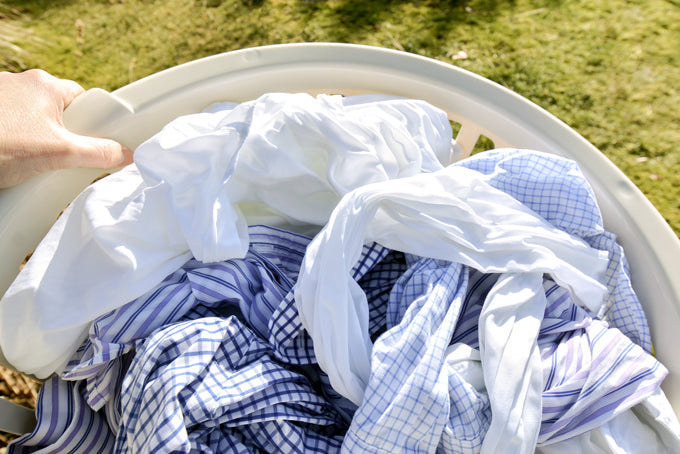Sunning: How to Take Advantage Of The Summer Sun by Outgassing (AKA Offgassing)
By Marilee Nelson |

What is Offgassing or Outgassing?
Offgassing or outgassing are interchangeable terms that relate to indoor air quality.
Offgassing refers to the release of VOCs (volatile organic compounds) from a material or solution that has been trapped or absorbed.
For example, when a room is freshly painted, the chemicals from the curing paint slowly offgas into the room as it dries.
In this case, you are smelling the VOCs releasing from the paint, which you recognize as the “fresh paint” smell.
Proper ventilation is essential to release the outgassing VOCs from the paint so they don’t become trapped in the room. Otherwise, they can incorporate back into porous materials and the indoor air quality suffers.
The consequences of outgassing can be significant if it collects in an environment where the air is stagnant with no ventilation.
The good news is, a material is considered fully outgassed when it is no longer releasing VOCs.
This means that any toxic VOCs have already been released and it will no longer continue to offgas into your indoor space.
Sniff-Testing
Want to perform a quick VOC test on something in your home? Try sniff-testing for VOCs!
Pick up an object like a book, a remote control, or a shower curtain liner. Smell the product closely.
Do you smell anything?
If the object smells neutral, it has likely offgassed already and is no longer releasing VOCs.
However, there’s a good chance, particularly if the item is new, that it still has a faint (or strong!) “new” smell.
This smell is a cue to your nose that the object is releasing VOCs and would make a good candidate for a sunning experiment.
Accelerate Outgassing with Sunning
You can actually speed up the outgassing process by using the heat of the sun.
Sunning is the process of using the sun to release or volatize the VOCs from a product.
The sun has historically been a powerful tool for brightening and whitening laundry and removing stains, but few people recognize it as an asset for removing toxins.
Sunning uses solar heat to release (outgas) VOCs from clothing, appliances, plastics, and essentially any new purchase.
Sunning is a very effective, fast, economical, and natural way to remove VOCs.
This method works just as well for new purchases and for older items that may have a musty smell.
You can also use sunning to offgas highly fragrant items from perfume, detergent, or smoke.
How To: Sunning New Purchases to Outgas VOCs
Summertime is the most efficient time of year to practice sunning because of the intense heat and long days.
Sunning can work on nearly any type of item, from fabrics and clothing to plastics, furniture, and even appliances.
The exception to this would be foam or latex. You should avoid sunning these materials because the UV rays from the sun will actually break down the material.
The sunning process is simple and the time required depends on the material.
It may take as little as a couple of hours or up to several days or weeks to completely outgas VOCs.
- Place an object in a sunny spot: On a sunny day, place your item in a spot that will have at least a few hours of sun exposure. This could be on a porch, patio, or deck, or even just in a grassy spot in the yard. Avoid an area that will get significant shade, as that will slow down the sunning process. The sunniest, hottest areas of the yard will volatize the chemicals most quickly.
- Rotate, turn, and allow air to circulate: Prop the object up towards the sun or lay the object on a table or basket that allows air circulation (see photo of the books below). Rotate the product as needed to get sun exposure on all sides.
- Check with a smell test: After one afternoon of sunning, check the item to determine if it still carries a smell. Many times just one afternoon in the sun will completely clear (outgas) all harmful VOCs. If the item still has a smell, place the item in the sun again for as many hours, or even days, as it takes to outgas.
Be aware that some materials fade or may be affected by extensive sun exposure.
A few hours is typically not an issue, but use common sense and observe material if outgassing procedure needs to be extended for a long period.
For sun sensitive items, just placing the material outside under cover of a porch or shade can also help to reduce VOCs.
Specific treatments:
- Clothing that has been washed in synthetic laundry products - these products have signature fragrances that are designed to impregnate the clothes. It is difficult to remove them entirely unless you sun them. You can save many washings and wear and tear on your clothes by using this sunning method. Turn the clothes inside out (to avoid sun-bleaching) and place in the sun. Turn the clothes over periodically and continue daily until the clothes are fragrance free. Remember to bring them in at night so they aren't exposed to the dew. Be persistent and be patient as it may take time. It is well worth the effort!
- Clothing and Linens: New clothes and other fabrics have VOCs from dyes and fabric treatments. Sunning, instead of washing, is the first step of choice. Turn the clothes inside out (to avoid sun-bleaching) and place in a sunny spot. If necessary, continue for several days or until all odor has gone from the garment.
- Dry Cleaned Items: Place dry cleaned clothes or other textiles in the sun or on a porch outside until they are completely outgassed. Conventional dry cleaning leaves perc in the clothing, which is a carcinogenic VOC. Consider green “dry” cleaning with no VOCs if there is a local option available.3
- Plastics: Anything from new electronics to plastic storage containers can and should be offgassed before bringing these items into the home. Even a new vacuum cleaner can be outgassed by sunning before use in the home.
- Paper: New books, paper products, and magazines may release VOCs from the chemically treated paper and ink. You can sun them in direct heat or you can air them out for a longer time on a covered porch until the “new” smell goes away.
- Antiques, Vintage, or Thrifted Items: Purchasing quality items secondhand can be a wonderful way to avoid VOCs, which have likely already offgassed (depending on the age of the item). However, these items may carry a fragrance from the shop or a stuffy garage or attic. When in doubt, try sunning the new purchase until any trace VOCs or fragrance are gone.
What else can you do to prevent outgassing inside?
1 - Make Your Home a No Smoking Zone
This one’s simple. Cigarette smoke carries many VOCs, including benzene, styrene, formaldehyde and ammonia.4
Don’t smoke inside and don’t allow family or guests to do that either.
2 - Identify and Remove Obvious Sources
Think about how it smells when you walk down the pesticide and cleaning product aisle in the grocery store.
For most people, the smell is so strong! They are emitting VOCs in ppm (parts per million), ppb (parts per billion), or even ppt (parts per trillion).
Those bottles are closed and sealed, yet the VOCs are escaping.
The same thing happens in your home, on a smaller scale, with all the bottles under your sinks and in cabinets.
These VOCs create a low level chemical soup, which your body has to constantly detoxify.
Remove all pesticides, toxic cleaning and personal care products from the home and garage.
This dramatically reduces VOCs, improves air quality and is a very simple effective first step in creating a healthy home.
3 - Choose Nontoxic Options for New Purchases and Construction
When making a new purchase, take the materials into consideration.
Choose natural fibers rather than synthetic blends (for example, a shower curtain or bed linens).
Select stainless steel or glass for cooking and food storage rather than plastic.
When shopping for furniture, look for options with untreated fabrics and materials or secondhand/vintage pieces, which would have already outgassed.
If you are remodeling or constructing a new home, look for materials that are low-VOC or no-VOC.
4 - Keep a Clean Home and Deep Clean Annually
Deep cleaning with a sealed system HEPA vacuum reduces VOCs that have incorporated into porous materials like drywall and upholstered furniture.
Routine cleaning with human-safe cleaners helps neutralize/release VOCs as it breaks down synthetic chemical residues into harmless byproducts.
If you’re concerned about excess VOCs in your home, a dry steam heat cleaner can accelerate removal of VOCs from walls and furniture.
5 - Bring in Some Fresh Air
Open all the windows in your home for 10 minutes twice a day.
In particular, open windows opposite each other in a room or across the house to create a cross breeze. This will help bring in oxygen, dilute the indoor air, and flush the air in the home.
Note: this works best when the wind is blowing or there is a significant difference in the outside temperature and the inside temperature, which creates a draft.
An example of this would be a chilly day when you have heated your home or on a very hot day when your home is air conditioned.
6 - Use Ventilation
Opening windows is helpful, but simply having the window open is not really enough to move air throughout your home.
On days when there is no wind or the inside temperature and the outside temperature are about the same, you will not have much airflow to move stagnant air out and fresh air inside your house.
Utilize fans to push air through your home and perhaps consider installing mechanical ventilation.
7 - Speed Up Outgassing in New Homes or Remodels
New homes and remodels typically have higher levels of VOCs.
VOC levels from new materials decrease over time due to the outgassing of the VOCs.
How long they outgas depends on the material or finish and the conditions on site.
For example, many low-VOC paints outgas to no odor relatively quickly, but the formaldehyde in new cabinets can outgas for years.
You can increase the rate of outgassing by opening windows during and after construction. Adding air movement with fans and using heat to warm up the new materials will accelerate the process.
A hot, dry summer day is the ideal time to offgas, as heat from the direct sun and low humidity will speed up the process of volatizing the VOCs.
If you are renovating in the wintertime or if climate conditions do not permit the use of sun, then you can supplement the offgassing with the use of a dry steam heat cleaner.
Offgassing a new home or a remodel may take days or even weeks of repeat sunning, use of fans, or dry steam heat treatments.
However, the improvements in air quality will make a dramatic difference when you consider that certain materials slowly release into your home for years if not properly offgassed.
Note: Higher temperatures and low humidity (below 50%) typically maximizes outgassing. It is important to take into consideration that materials expand and contract and can be affected by extremes of temperature and humidity. This may become more of an issue with long term outgassing projects.
8 - Store High-VOC Items in a Detached Shed or Garage
Some items continually outgas.
Gas cans and gas-powered tools, like lawn equipment, should be stored away from the living space.
Further Reading
What are VOCs?
Find out everything you need to know about Volatile Organic Compounds and How They Affect Your Health.
Break the fragrance habit. Use these Nontoxic Air Fresheners instead of the synthetic variety to remove odors.
Keep reading about synthetic chemicals to avoid in your home: Common Household Chemicals to Avoid – A Branch Basics Series.
Address SVOCs with a HEPA Vacuum. HEPA filters are indoor air pollution’s worst nightmare. Here’s How to Choose One for Your Home.
Going on a trip? Check out our Healthy Travel Guide for our favorite travel snacks and tips for preventing sunburn, jetlag, and more!
Improve your indoor air quality by using The Official Branch Basics Deep Cleaning Method.
Categories

Marilee Nelson
Marilee Nelson is an Environmental Toxins expert who has spent nearly 30 years advocating for the chemically-sensitive and chronically-ill. She is a Board Certified Nutritionist, Certified Bau-Biologist and Bau-Biology Inspector and specializes in Food As Medicine. She has helped thousands of families and individuals identify, heal and recover from toxic exposures and is on a mission to revolutionize the way American families view their health.









